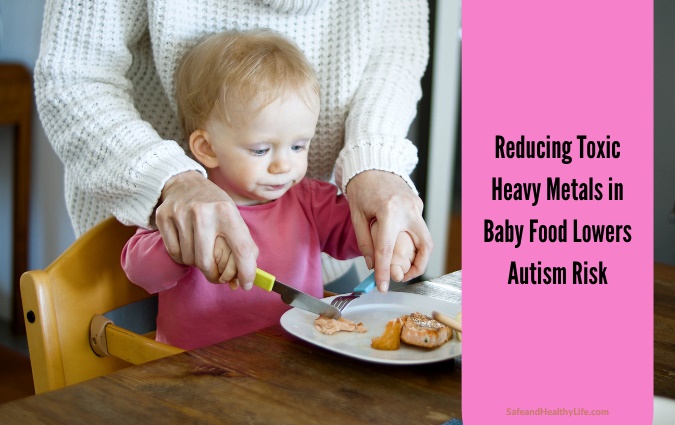
A February 2021 congressional report from the Subcommittee on Economic and Consumer Policy uncovered alarming facts concerning the contents of U.S. infant nutrition products. The results indicate the presence of excessive amounts of toxic heavy metals and substandard internal safety policies.
Heavy metals are naturally occurring elements that have a significant role in nutrition. Calcium, iron, and zinc are required for proper development in adequate amounts. Conversely, unsafe elements like mercury, cadmium, lead and inorganic arsenic have no safe exposure level and are known neurotoxins associated with neurodevelopmental disabilities.
Autism Linked to Toxic Heavy Metal Exposure
A consensus hasn’t been reached yet regarding the precise causes of autism spectrum disorders (ASD). Multiple factors are likely involved, including environmental exposure and genetics. Mounting evidence shows that children diagnosed with ASD have higher counts of toxic heavy metals in their system. The staggering amounts of these contaminants in baby food products represent a potential exposure risk.
Since infants absorb more nutrients and have underdeveloped filtering and immune systems, they’re highly susceptible to the adverse effects of neurotoxins. These harmful heavy metals accumulate in bones and tissues and steadily lead to deficiencies in neurological development.
Limited Industry Reaction Prompts Legislative Action
The Subcommittee’s report was received with lukewarm reactions from the baby food industry. Not only did 3 out of the 7 companies involved in the investigation refuse to cooperate, product recalls following publication was low. This limited response from the industry attracted the FDA’s attention, which initiated its “Closer to Zero” action plan. Congressman Raja Krishnamoorthi proposed the Baby Food Safety Act of 2021 to restrict toxic metals in baby food.
A coalition of 24 Attorneys General echoes the pending bill’s stipulations. In a petition addressed to the FDA, the coalition notes that the Agency should impose stricter regulations and speed up its action plan’s timeline. The most common demands reflect the need for manufacturers to ensure final product safety and improve internal regulations.
| Read also: [The Parents Have Spoken] Do You Know These Top 8 Autism Therapies for Children? |
Parents Increasingly Seeking Safer Alternatives
A follow-up to the first report indicated even higher contamination levels following the cooperation of initially hesitant companies. With several manufacturers knowingly commercializing unsafe products, parents gradually pursue viable alternatives to popular brands. Fortunately, parents can include several common-sense approaches to infant nutrition in their toddler’s diets:
Breastfeeding Is Vital During the First Year
The most crucial aspect of a baby’s proper development is sufficient breastfeeding. Recommended for a minimum of 6 months and up to a year, pediatricians note that the nutritional value of mother’s milk is unmatched.
Besides the essential proteins, fats, vitamins, and minerals that encourage growth, breastfeeding also bolsters the immune system and reduces the likelihood of chronic diseases and infections. During this nurturing period, mothers should be mindful of their intake. Avoiding products high in toxic heavy metals limits exposure to their infants.
Rice Should Be Replaced
Rice is a notoriously absorbent crop with an inorganic arsenic count up to 20 times higher than other cereals. Derived products such as rice flour aren’t any safer. Even if sushi and basmati rice are seen as safer substitutes, rice as an ingredient should be used sparingly.
The only FDA heavy metal regulation for baby food applies to arsenic levels in rice infant products. Suitable replacements with a similar texture include oats, rye, barley, maize, soy, and wheat.
Avoid Mercury-Rich Fish
Fish and various seafood are highly nutritious options when transitioning to solids. Unfortunately, some fish have a high mercury concentration and should not be included in a baby’s diet. Species that should be avoided include mainly predatory types like a shark, marlin, swordfish, bigeye tuna, and king mackerel.
Parents should consider healthier fish options such as light canned tuna, salmon, trout, herring, sardines, or pollock. Other beneficial seafood choices include scallops, shrimp, lobster, oysters, and crawfish.
Informed Choices
The non-profit organization Healthy Babies Bright Futures was instrumental in bringing the toxic contamination crisis to the public’s attention. They provide a few tips on reducing unsafe metal levels in toddlers’ diets.
- Rice-free packaged snacks mitigate exposure to arsenic, lead, and cadmium by 93%.
- Multi-grain cereal varieties like oatmeal, corn, quinoa, and barley contain 84% less arsenic than infant rice cereal.
- Crops like sweet potatoes and carrots are high in lead and cadmium. A broader selection of vegetable and fruit choices can reduce exposure by 73%.
- Juice derived from fruits like apples, grapes, or pears contains traces of arsenic and lead. Switching to water reduces heavy metal exposure by 68%.
- Frozen or chilled vegetables and fruit are safer options than teething biscuits.
“Organic” products aren’t automatically “safe” since they can still absorb harmful elements from the soil and water used in the cultivation process. Parents can also apply for safer alternatives through the Toxic Baby Food Replacement Initiative, which provides adequate substitutes that don’t exceed heavy metal safety levels.
About The Author:
Jonathan Sharp is the CFO at Environmental Litigation Group, P.C., a law firm situated in Birmingham, Alabama, specializing in toxic exposure cases.




